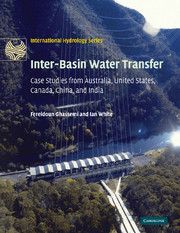Book contents
- Frontmatter
- Contents
- Foreword
- Overview and Scope
- Acknowledgements
- List of Abbreviations
- Part I The Challenges
- 1 World population and pressures on land, water and food resources
- 2 Issues in inter-basin water transfer
- Part II Inter-basin Water Transfer in Australia
- Part III Inter-basin Water Transfer in Other Selected Countries
- Part IV Appendices
- Glossary
- Index
- References
1 - World population and pressures on land, water and food resources
Published online by Cambridge University Press: 05 November 2009
- Frontmatter
- Contents
- Foreword
- Overview and Scope
- Acknowledgements
- List of Abbreviations
- Part I The Challenges
- 1 World population and pressures on land, water and food resources
- 2 Issues in inter-basin water transfer
- Part II Inter-basin Water Transfer in Australia
- Part III Inter-basin Water Transfer in Other Selected Countries
- Part IV Appendices
- Glossary
- Index
- References
Summary
POPULATION
The world population was about 200 million in the year 500 ad, 275 million in the year 1000, 450 million in 1500 and one billion around 1800 (Cohen, 1995, Appendix 2). While the world population took most of human history to reach one billion, subsequent additions came much faster: 130 years to reach 2 billion, 30 years to reach 3 billion, then 14, 13, and 12 years to reach 4, 5, and 6 billion respectively (Gilbert, 2001, p. 1). The high rate of population growth in recent decades has been the result of improvements in public health and sanitation that have reduced the mortality rate, particularly in the developing countries. The population growth rate peaked at 2.1 percent per year during the period 1965–70 (World Bank, 1992, pp. 25–26) and then started to decline to 1.7 percent over the period 1975–80 and 1.3 percent (or approximately 80 million a year) over the period 1995–2000. The fertility rate declined from 3.9 in 1975–80 to 2.7 for the period 1995–2000 (Table 1.1).
The world population increased from about 2.5 billion in 1950 to 6 billion in 2000, representing an increase of 2.4 times, and is expected to reach 7.8 billion by 2025 (Table 1.1). Most of this increase will take place in the developing world. It is expected that Asia will reach a population of 4.3 billion and Sub-Saharan Africa 1.1 billion by the year 2025.
- Type
- Chapter
- Information
- Inter-Basin Water TransferCase Studies from Australia, United States, Canada, China and India, pp. 3 - 21Publisher: Cambridge University PressPrint publication year: 2007

